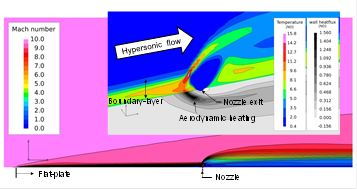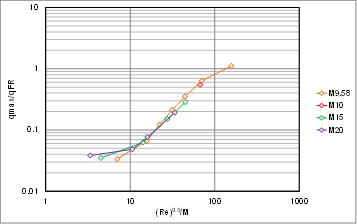Prediction of RCS Jet Interaction on Re-entry Capsule
JAXA Supercomputer System Annual Report April 2016-March 2017
Report Number: R16E0009
- Responsible Representative: Shigeru Hamamoto(Aeronautical Technology Directorate, Aerodynamics Research Unit)
- Contact Information: Hajime Miki(miki.hajime@jaxa.jp)
- Members: Hajime Miki, Kie Okabayashi, Yoshiki Takama, Keisuke Fujii
- Subject Category: Space(Space transportation)
Abstract
JAXA progresses research and development on lifting re-entry capsule as a return procedure for manned space activity. In atmospheric re-entry, gas jets emitted from reaction control system (RCS) interact with external flow around a capsule aero-thermodynamically. In order to predict its influence on capsule’s aerodynamic and aerodynamic heating, RCS jet interaction is examined in various flow conditions by using not only wind tunnel testing but also CFD analysis.
Goal
Obtaining a prediction technique of RCS jet interaction for improving guidance control and thermal protection design of a lifting re-entry capsule
Objective
Discovering a parameter which correlates aerodynamic heating due to RCS jet interaction and main flow conditions by using both CFD analysis and wind tunnel testing
References and Links
N/A
Use of the Supercomputer
The supercomputer, JSS2, was used for CFD analysis of RCS jet interaction on a re-entry capsule.
Necessity of the Supercomputer
In order to improve a productivity of CFD data which cover wide condition of main flow and RCS jet, the use of JSS2 was necessary.
Achievements of the Year
CFD analysis using FaSTAR code was conducted against a model designed to simplify RCS jet interaction (Fig.1), and heating rate on the wall relative to free stream condition was examined. The results showed that the heating rate becomes larger as Reynolds number increase or as Mach number decrease. And it was found that a viscous interaction parameter correlates well with the change of aerodynamic heating due to free stream condition (Fig.2). Furthermore, the same trends appeared in the CFD analysis of re-entry capsule, and the effect of Reynold number matched with the results of wind tunnel testing qualitatively.
Publications
N/A
Computational Information
- Parallelization Methods: Process Parallelization
- Process Parallelization Methods: MPI
- Thread Parallelization Methods: n/a
- Number of Processes: 128
- Number of Threads per Process: 1
- Number of Nodes Used: 4
- Elapsed Time per Case (Hours): 20
- Number of Cases: 50
Resources Used
Total Amount of Virtual Cost(Yen): 1,085,633
Breakdown List by Resources
| System Name | Amount of Core Time(core x hours) | Virtual Cost(Yen) |
|---|---|---|
| SORA-MA | 637,281.96 | 1,047,728 |
| SORA-PP | 117.23 | 1,000 |
| SORA-LM | 0.00 | 0 |
| SORA-TPP | 0.00 | 0 |
| File System Name | Storage assigned(GiB) | Virtual Cost(Yen) |
|---|---|---|
| /home | 13.70 | 129 |
| /data | 1,229.21 | 11,595 |
| /ltmp | 2,669.27 | 25,179 |
| Archiving System Name | Storage used(TiB) | Virtual Cost(Yen) |
|---|---|---|
| J-SPACE | 0.00 | 0 |
Note: Virtual Cost=amount of cost, using the unit price list of JAXA Facility Utilization program(2016)
JAXA Supercomputer System Annual Report April 2016-March 2017




